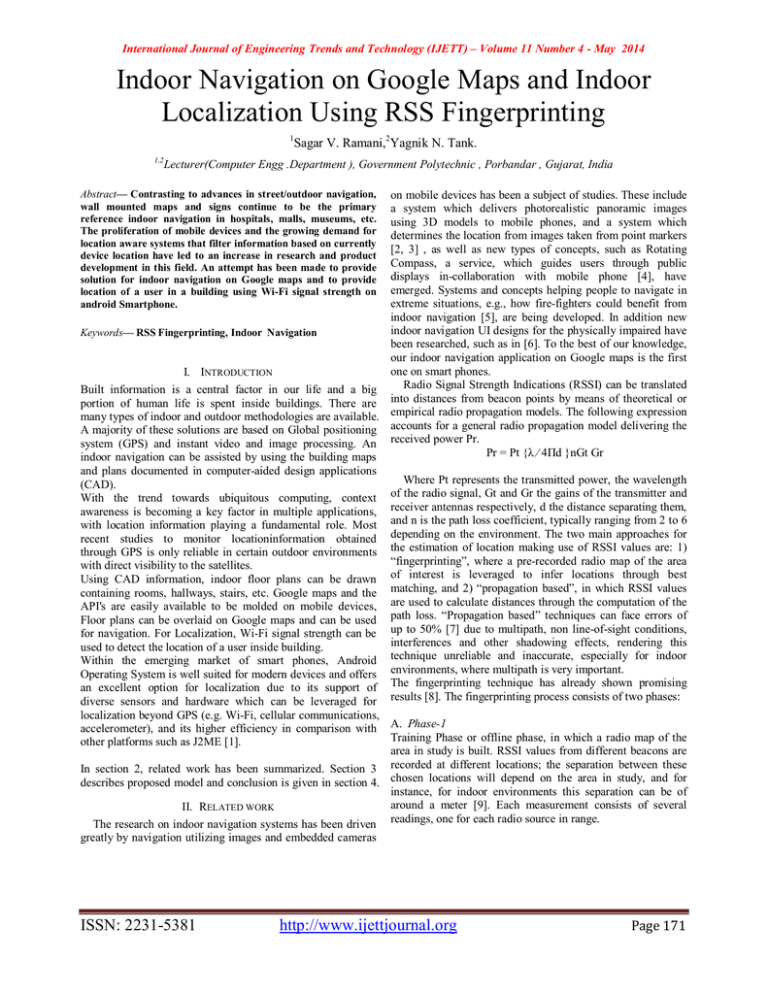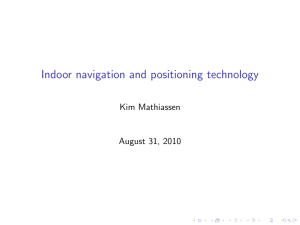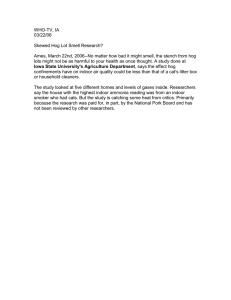Indoor Navigation on Google Maps and Indoor Localization Using RSS Fingerprinting
advertisement

International Journal of Engineering Trends and Technology (IJETT) – Volume 11 Number 4 - May 2014
Indoor Navigation on Google Maps and Indoor
Localization Using RSS Fingerprinting
1
1,2
Sagar V. Ramani,2Yagnik N. Tank.
Lecturer(Computer Engg .Department ), Government Polytechnic , Porbandar , Gujarat, India
Abstract— Contrasting to advances in street/outdoor navigation,
wall mounted maps and signs continue to be the primary
reference indoor navigation in hospitals, malls, museums, etc.
The proliferation of mobile devices and the growing demand for
location aware systems that filter information based on currently
device location have led to an increase in research and product
development in this field. An attempt has been made to provide
solution for indoor navigation on Google maps and to provide
location of a user in a building using Wi-Fi signal strength on
android Smartphone.
on mobile devices has been a subject of studies. These include
a system which delivers photorealistic panoramic images
using 3D models to mobile phones, and a system which
determines the location from images taken from point markers
[2, 3] , as well as new types of concepts, such as Rotating
Compass, a service, which guides users through public
displays in-collaboration with mobile phone [4], have
emerged. Systems and concepts helping people to navigate in
extreme situations, e.g., how fire-fighters could benefit from
indoor navigation [5], are being developed. In addition new
indoor navigation UI designs for the physically impaired have
Keywords— RSS Fingerprinting, Indoor Navigation
been researched, such as in [6]. To the best of our knowledge,
our indoor navigation application on Google maps is the first
one on smart phones.
I. INTRODUCTION
Radio Signal Strength Indications (RSSI) can be translated
Built information is a central factor in our life and a big
into
distances from beacon points by means of theoretical or
portion of human life is spent inside buildings. There are
many types of indoor and outdoor methodologies are available. empirical radio propagation models. The following expression
A majority of these solutions are based on Global positioning accounts for a general radio propagation model delivering the
system (GPS) and instant video and image processing. An received power Pr.
Pr = Pt {λ ⁄ 4Πd }nGt Gr
indoor navigation can be assisted by using the building maps
and plans documented in computer-aided design applications
Where Pt represents the transmitted power, the wavelength
(CAD).
of
the radio signal, Gt and Gr the gains of the transmitter and
With the trend towards ubiquitous computing, context
awareness is becoming a key factor in multiple applications, receiver antennas respectively, d the distance separating them,
with location information playing a fundamental role. Most and n is the path loss coefficient, typically ranging from 2 to 6
recent studies to monitor locationinformation obtained depending on the environment. The two main approaches for
through GPS is only reliable in certain outdoor environments the estimation of location making use of RSSI values are: 1)
“fingerprinting”, where a pre-recorded radio map of the area
with direct visibility to the satellites.
Using CAD information, indoor floor plans can be drawn of interest is leveraged to infer locations through best
containing rooms, hallways, stairs, etc. Google maps and the matching, and 2) “propagation based”, in which RSSI values
API's are easily available to be molded on mobile devices, are used to calculate distances through the computation of the
Floor plans can be overlaid on Google maps and can be used path loss. “Propagation based” techniques can face errors of
for navigation. For Localization, Wi-Fi signal strength can be up to 50% [7] due to multipath, non line-of-sight conditions,
interferences and other shadowing effects, rendering this
used to detect the location of a user inside building.
Within the emerging market of smart phones, Android technique unreliable and inaccurate, especially for indoor
Operating System is well suited for modern devices and offers environments, where multipath is very important.
an excellent option for localization due to its support of The fingerprinting technique has already shown promising
diverse sensors and hardware which can be leveraged for results [8]. The fingerprinting process consists of two phases:
localization beyond GPS (e.g. Wi-Fi, cellular communications,
accelerometer), and its higher efficiency in comparison with A. Phase-1
Training Phase or offline phase, in which a radio map of the
other platforms such as J2ME [1].
area in study is built. RSSI values from different beacons are
In section 2, related work has been summarized. Section 3 recorded at different locations; the separation between these
describes proposed model and conclusion is given in section 4. chosen locations will depend on the area in study, and for
instance, for indoor environments this separation can be of
around a meter [9]. Each measurement consists of several
II. RELATED WORK
The research on indoor navigation systems has been driven readings, one for each radio source in range.
greatly by navigation utilizing images and embedded cameras
ISSN: 2231-5381
http://www.ijettjournal.org
Page 171
International Journal of Engineering Trends and Technology (IJETT) – Volume 11 Number 4 - May 2014
B. Phase-2
Online phase, in which the mobile terminal infers its location
through best matching between the radio signals being
received and those previously recorded in the radio map.
Regarding Wi-Fi technology, several research groups have
already tried to leverage RSSI fingerprinting for localization:
Radar: Represents the first fingerprinting system achieving the
localization of portable devices, with accuracies of 2 to 3
meters.
•
•
•
Horus: based on the Radar system, it manages a
performance
improvement making use of
probabilistic analysis.
Compass: applies probabilistic methods and
leverages object orientation to improve precision,
claiming errors below 1.65 meters.
Ekahau: commercial solution using 802.11 b/g
networks, achieving precisions from 1 to 3 meters in
normal conditions.
Nevertheless, all the existing approaches use dedicated and
complex hardware, making them unfeasible for direct
implementation in smart phones.
The RSS fingerprinting technique for localization can be
utilized with other radiofrequency technologies including:
•
Bluetooth, which despite the extra infrastructure
requirements in comparison with Wi-Fi, it can
achieve accuracies in the range of 1.2 meters.
•
Conventional radio can also be used for localization.
However, the requirement of dedicated hardware and
the fact that devices can be located only down to a
suburb, represent important drawbacks.
•
Digital TV signals have also proved to be suitable for
localization, but subject to dedicated hardware
requirements and low resolutions.
III. PROPOSED MODEL
A. Indoor Navigation on Google maps:
We have studied the possibility of providing indoor
navigation on Google maps. The two floors of F-block,
PESIT, Bangalore were considered for providing navigation.
The floor plans were drawn on AutoDesk Online IDE using
the blueprint of building. The aim was to exactly overlay the
floor plans of building on the Google maps so that Geocodes
(Latitude, longitude) information can be accurately collected
for the rooms, Corridors, Stairs, etc. The building elements
(rooms, corridors, stairs, etc.) are considered as nodes (source
or destination). The edges are link between different nodes.
Dijkstra’s algorithm was considered for providing shortest
path between nodes. The Google map and android application
can be integrated using Google map API key. The Geocodes
were collected using Google maps, Geocodes represent the
nodes on the floor plan. The Dijkstra’s algorithm sends the
shortest path, the edge is drawn between nodes using the
geocodes.
ISSN: 2231-5381
Fig 1: Floor Plan on a Google map
B. Indoor Localization using RSS fingerprinting
RSS information from Wi-Fi beacons deployed within
buildings allows us to obtain a radio map of different locations
(Technique called fingerprinting), and we will estimate
locations through the comparison of the current RSS
measurements with those stored in the radio map. Different
attempts to obtain RSS-based indoor localization without
fingerprinting show an important loss of accuracy[10].Also,
many fingerprinting-based localization systems make use of
dedicated hardware for the collection of data in the training
phase, while in the measurement phase, the actual mobile
device used for localization is different, resulting in an error
called “signal reception bias” [11], due to the differences in
antennas characteristics and measurement acquisitions
schemes between different equipment. We have carried out
tests to measure different radiofrequency signal strengths
within the PESIT F-block. Wi-Fi technology offers the most
reliable approach for indoor localization in our building,
because of the important deployed infrastructure of Wi-Fi
Access Points providing coverage in the whole building. For
the measurement of the signals and practical implementation
of our localization application, we have used smart phones
running on Android.In our experimental setup, each Wi-Fi
Access Point has 5 radios (each represented by a MAC
address).
http://www.ijettjournal.org
Page 172
International Journal of Engineering Trends and Technology (IJETT) – Volume 11 Number 4 - May 2014
TABLE II
FEW RADIO MAPS DATA OF ISE DEPT. OFFICE
Fig 2: RSS logger Application
For example, 00:19:5b:b1:23:90, 00:23:04:89:24:08,
00:23:04:89:1f:98, 00:23:04:89:67:e7 and 00:23:04:89:22:00
are 5 radios belonging to the same Access Point(PESITRB).
RSS values (in dBm) from the same Access Point can show
important standard deviations in between consecutive scans
(within the same radio) and also in between different radios
within the same Access Point. Consequently, averaging of
values both within the same Access Point and over time
provides much more stable values that can successfully be
used as a fingerprintcomponent of each particular location.
We call this approach “Nearest Neighbour in signal space and
Access Point averages”.It must also be noticed that there are
radios which only show up at some particular locations, but
with a very low RSS value. For instance, 00:0c: ff: b0:01:d0
could only be noticed in a small area in our building with 3
dBm. Nevertheless, this information with so low RSS values
can be considered as noise, and therefore it is not reliable to
use radios with RSS below 15 dBm as a disambiguation factor.
The useful information to disambiguate locations can be found
at RSS values above 15 dBm, which in our case corresponds
to approximately 3 Access Points with stable enough values to
allow us to correctly distinguish between the different
locations.
TABLE I
FEW RADIO MAPS DATA OF AUDITORIUM
SR
NO.
SSID
BSSID
RSSI( dBm )
1
PESITRB
24:08
-62
2
PESITRB
23:90
-80
3
PESITRB
1f:98
-53
4
CISCO_LAB
67:e7
-85
ISSN: 2231-5381
SR
NO.
SSID
BSSID
RSSI( dBm )
1
PESBHMWIFI01
27:78
-85
2
PESITRB
23:90
-86
3
PESBHMWIFI01
1a:90
-68
IV. CONCLUSION
We have developed an approach to provide indoor
navigation on Google maps. This application can be used in
any huge buildings where indoor navigation is necessity. An
indoor localization application to be implemented in smart
phones, leveraging their sensing capabilities in order to
deliver up to 1.5 meters accuracy without the requirements for
complex hardware that existing solutions need. This
application delivering up to 1.5 meters resolution making use
of only the hardware embedded within the phone and
integrating both online and offline phases of RSSI
fingerprinting within the same device.
REFERENCES
[1]
[2]
[3]
[4]
[5]
[6]
Pathanawongthum, N. Cherntanomwong, P. 2009. Empirical evaluation
of RFID-based indoor localization with human body effect”, 15th AsiaPacific Conf. on Communications, 2009, 479-482.
Miyazaki, Y. Kamiya, T., “Pedestrian Navigation System for Mobile
Phones Using Panoramic Landscape Images”. In Proc. of SAINT’06,
2006, IEEE Computer Society, 102-108.
Mulloni A, Wagner D, Barakonyi D, Schmalstieg I, “Indoor Positioning
and Navigation with Camera Phones”. IEEE Pervasive Computing,
2009, 8(2): 22-31.
Rukzio E, Müller, M, Hardy R, “Design, Implementation and Evaluation
of a Novel Public Display for Pedestrian Navigation: The Rotating
Compass”.In Proceedings of CHI’09, ACM Press 2006, 113-122.
Ramirez L, Denef S, Dyrks T, “Towards Human-Centered Support for
Indoor Navigation”. In Proc. of CHI’09, 2009, 1279-1282.
Hub A., Diepstraten J, Ertl T, “Design and Development of an Indoor
Navigation and Object Identification System for the Blind”.In Proc.
ASSETS’04, 2004,147-152.
[7]
Poovendran R, Wang C, Sumit R, “Secure Localization and Time
Synchronization for Wireless Sensor and Ad Hoc Networks”, Springer,
2006.
[8] Brida P, Cepel P, and Duha J, “Geometric Algorithm for Received
Signal Strength Based Mobile Positioning, Proc. Of Czech Slovak
Technical Universities & URSI”, v. 5, 2005. 176-197
[9] Varshavsky A., Lara E, Hightower J, Lamarca A, Otsason V. 2007,
GSM indoor localization, Pervasive and Mobile Computing, 2007, 698720.
[10] Li X, 2009. Ratio-based zero-profiling indoor localization, IEEE 6th Int.
Conf. MASS, 2009, 40-49.
[11] Hsu C, Yu C. “An Accelerometer based approach for indoor
localization”, Symposia and Workshops on UIC'09 and ATC'09
Conferences, 2009, 223-227.
http://www.ijettjournal.org
Page 173






